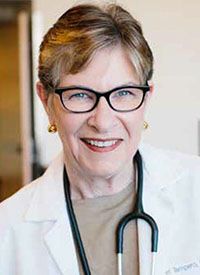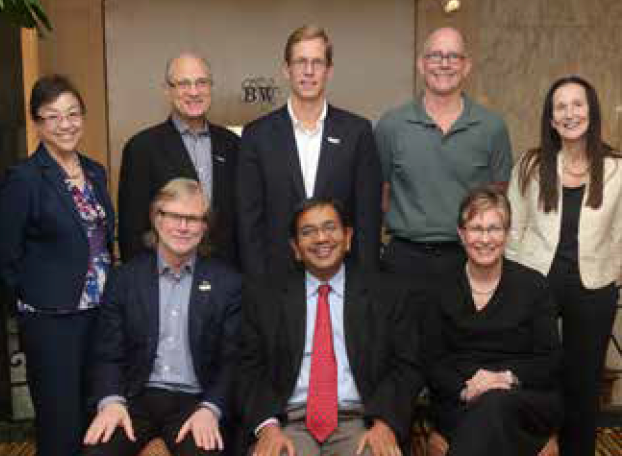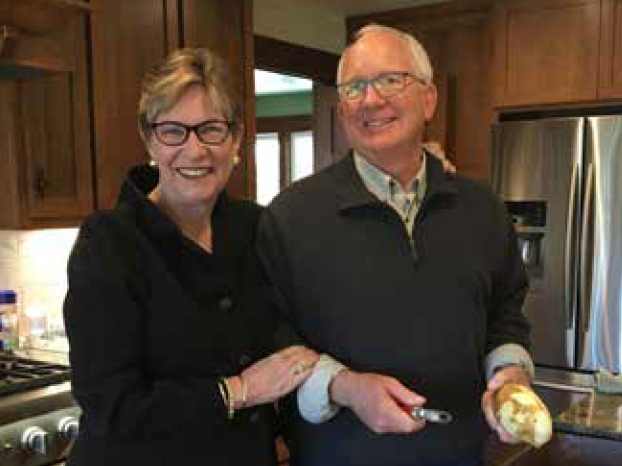Pancreatic Cancer “Evangelist” Collaborates to Save Lives
If there is one touchstone that emerges from Dr. Margaret A. Tempero's career of studying and treating pancreatic cancer, it is her persistence in simply trying to help her patients.
Margaret A. Tempero, MD

One fateful night shift, a patient presented in an emergency department with renal failure, a complication from cancer that had spread, blocking both kidneys. Margaret A. Tempero, MD, then an intern, was there on rotation.
She spent the night triaging the patient’s symptoms, addressing what could be treated in an effort to stabilize him. In the morning, the patient woke up and said that he was grateful for the time and attention Tempero paid to his care.
“We talked a bit and he said, ‘You know, I know that I am dying, but I’m so grateful that you are giving me a little bit more time so that I can see my daughter get married,’ ” Tempero recalled. “And I thought, ‘You know, this is pretty fantastic, to work with people who are in need of your care and so grateful for everything that you do.’ And that’s been the gift to me, my entire career.”
If there is one touchstone that emerges from Tempero’s career of studying and treating pancreatic cancer, it is her persistence in simply trying to help her patients. The pancreatic cancer field has seen little improvement in rates of survival, there are few approved regimens, and the disease lacks identifiable therapeutic targets compared with other malignancies. A rare malignancy, pancreatic adenocarcinoma accounts for approximately 3.2% of all new cancer cases in the United States but 7.8% of cancer deaths. With limited resources, data, and understanding, success requires a knack for seeking out opportunities to just begin treating 1 patient at a time.
Tempero chooses to see the landscape less as a daunting challenge and more as an exciting one. She takes an interdisciplinary approach to practice, one that relies on collaboration not just between investigators in the field but also across disciplines.
“My entire career, I’ve always said now is the most exciting time—not knowing what was goingto come ahead,” Tempero said. “The more you learn and understand, the better your strategy will be in how you tackle the enemy.”
Searching for the Impossible
Pancreatic cancer was not always in the cards for Tempero; at first, specializing in the field seemed to her like a dead end. While she was working in the clinic with her mentor, 2018 Giants of Cancer Care® recipient James O. Armitage, MD, a conversation set her on the course of looking into the impossible and finding a way forward.
Four decades ago, Tempero was researching colon cancer prevention strategies and potential treatments for patients with lymphoma. Armitage encouraged her to pursue gastrointestinal cancers, but she was reluctant to leave the lively field of lymphoma for a sector that seemed stagnant.
“I said to him, ‘What a horrible idea. I can work with you and I can cure patients and you’re sending me off to this wasteland where we have nothing?’ He said, ‘That’s exactly why you should do it—to find more things that you could do.’ So I followed his advice, and I actually began to love it,” Tempero said.
That “wasteland” turned out to be the ground floor of several practice-changing investigational therapeutics. “It became even more crystal clear to me that pancreas cancer patients are the neediest patients of all,” Tempero said. “Not only was there no one who seemed to be interested in working on this problem, but these patients have a very, very aggressive malignancy.” The first window of opportunity presented itself in the form of a novel biomarker. Tempero and her team laid the groundwork for CA 19-9, a Lewis carbohydrate antigen, as a serum marker for disease recurrence, progression, and treatment efficacy. CA 19-9 remains one of the best-validated and most clinically useful biomarkers for early detection and surveillance of pancreatic cancer, with a sensitivity rate of 79% to 81% and a specificity rate of 80% to 90% in symptomatic patients.
A second opening for innovation arrived in the form of exploring systemic treatment options. Even after nearly a century of surgical improvements, just 20% of patients with a new diagnosis of pancreatic cancer present with resectable disease. Thus, the focus shifted from surviving surgery to surviving the cancer because 5-year survival rates have been slow to signal progress. At the time of Armitage’s suggestion in the 1980s, patients with pancreatic cancer were limited to systemic treatment with fluorouracil (5-FU) and the 5-year relative survival rate was approximately 3%.
Tempero turned her attention to researching therapies to increase survival for patients. This led to exploration of the utility of gemcitabine and the development of a fixed-dose regimen to maximize the agent’s efficacy. Tempero’s team at the University of California, San Francisco (UCSF), forged ahead with new gemcitabine combinations and also studied the sequencing of treatment in patients with localized disease. Combined with the aggregate effort of a global community, this therapy has improved the 5-year survival rate to greater than 10%.
The Temperos at the family home in Sonoma County, California, in 2012. Pictured are Rick Tempero, MD, PhD, and Jonell Tempero, and their children, Mack and Ellie; Margaret Tempero’s parents, Eric Tempero, and Drs Margaret and Richard Tempero.

Advocating for Pancreatic Cancer
Although these advances improved survival and symptom relief statistics over the past several decades, measurable progress took another form: expanding the dissemination of knowledge, raising awareness, and encouraging collaboration across disciplines. Narrowing the focus from all gastrointestinal cancers to pancreatic cancer meant finding new opportunities. “I would be asked, ‘Would you come and give a talk on colon cancer?’ And I’d say, ‘No, but I’ll come and give a talk on pancreatic cancer.’ And so, when I spoke, I also became an evangelist recruiting people to work on this disease, engaging the community to conduct more research,” Tempero said.
That attention to filling a knowledge gap led Tempero to host the first Pancreas Cancer Think Tank in Park City, Utah, in 1999. The meeting gathered leaders in the field, including 64 scientists, some of whom were dedicated to pancreas cancer research, 6 National Cancer Institute (NCI) investigators, and 12 representatives from industry. The 6 working groups produced a comprehensive white paper covering every aspect of the disease, from genetics, risk factors, and prevention to histology, biology, and therapy.
“I got enough people in the room who either already had an interest or probably should have an interest based on what they do,” Tempero said. “Many people will tell you that meeting was the instigating moment that changed their career and made them focus on pancreatic cancer as a part of their mission.”
However, she counts 2 organizations as being pivotal to increasing the body of knowledge for investigators by providing and fighting for funding for pancreatic cancer research. The first to be established was the grassroots Pancreatic Cancer Action Network, which offers extensive patient education and support for competitive research grants through donations and advocates for increased federal research funding. Tempero got involved early on, as the founders looked to build a community element where investigators would not only get funding but also collaborate to tackle scientific questions.
“I was approached the founders of the Pancreatic Cancer Action Network, and they said, ‘We want to create a foundation to support research in pancreatic cancer.’ And it is a credit to the succession of people who led the Pancreatic Cancer Action Network that we began to develop a community. I said, ‘That’s what we need to do. We need to provide funding so people could get started, and then we need to keep the community together so that they’ll feed on each other’s energy and keep things going,’ ” Tempero said.
Tempero also considers herself fortunate to having been a founding board member for the Lustgarten Foundation. In 1998, at age 51, Cablevision Vice Chairman Marc Lustgarten received a diagnosis of pancreatic cancer; he died less than a year later.
“I was one of many people who helped in the care of Marc Lustgarten, and there was a considerable amount of interest from his colleagues supporting research in his name,” Tempero said. The Lustgarten Foundation has become one of the largest private funders of pancreatic cancer research and has teamed up with Stand Up to Cancer (SU2C) to support large multi-institutional teams focused on treatment and early detection.
Tempero, first row, right, was a founding board member of the Pancreatic Cancer Action Network and she is the current chairelect for the network’s Scientific and Medical Advisory Board. She poses here with her fellow board members.

Paving the Road for the Role of a Lifetime
These roles across organizations, in academic administration, and in positions of influence across a world-renowned organization culminated in Tempero’s dream job. In 2012, she founded the UCSF Pancreas Center, a facility that specializes in treating patients with a range of pancreatic afflictions. The cross-discipline team consists of specialists in oncology, surgery, gastroenterology, pathology, radiology, nursing, psychology, and many lab-based scientists.
“When I stepped down from my leadership position at the UCSF Helen Diller Family Comprehensive Cancer Center in 2012, I talked with the dean and said, ‘What I’d really like to do with the rest of my career is to run a pancreas center at UCSF. What better place could there be to do this?’ The leadership at UCSF made it possible for me to basically create and do my dream job,” Tempero said.
Less than 5 years into her new role, another collaborative opportunity came across her desk, this time in the form of a grant provided by the Pancreatic Cancer Collective. This initiative of the Lustgarten Foundation and SU2C was established to build on the field’s momentum.
Leveraging the collective strengths of University of California (UC), San Diego and UCSF, Tempero has worked with Andrew M. Lowy, MD, chief of surgical oncology at the Moores Cancer Center at UC San Diego Health, to investigate key pathways for the development of agents designed to limit the progression of disease. That collaboration led Tempero and Lowy to form the UC Pancreas Cancer Consortium, which unites the research programs at all 5 UC NCI-designated cancer centers and is among the largest research enterprises of its kind in the world.
Tempero speaks with admiration and affection not only for her colleagues in these endeavors but also for the patients who will benefit from their collective success. Dedication and grit enabled her to thrive in the field, but she humbly describes herself as fortunate to be part of this moment in research.
“I am the luckiest person in the world right now because I have a job that I absolutely love,” Tempero said. “I’m working with some of the best talent in the world. And we are really focused on minimizing the burden of pancreatic cancer, not just in the state of California, but globally. I just can’t even imagine something better than this. I still see patients, which I can’t stop doing, because I love working with them. They keep me grounded and remind me why we need to work so hard.”
Tempero, pictured at home with her husband, Richard Tempero, MD, DDS, says she would not be where she is today without the support and understanding of her family.

Facing Continued Change
Outside the hospital walls and away from a unique medical specialty with seemingly endless possibilities but no clear-cut starting points, Tempero faces another challenge. Collecting art has long been a great joy for her and her husband, Richard M. Tempero, MD, DDS, but they now find themselves rebuilding their collection following the loss of their home in the wildfires that swept through the North Bay area in 2017.
“We lost our art that we love so much and everything else that we had there, as well,” Tempero said. “So, while we will never have the important collection we had before, we can still surround ourselves with works that give us comfort.”
Regardless of where she resides, none of the collaboration and advances that she achieved outside the home would have been possible without the support of her family. Tempero and her husband met at UCSF, and she joined him in Omaha, Nebraska, where he attended dental school at Creighton University. She earned a degree in medical technology at Creighton.
Following graduation, Tempero pursued a career in the field to help support her husband’s dental school tuition. By the time she decided to take her own leap into medical schooling, Tempero was the mother of a 5-year-old and her husband was attending medical school, en route to earning an MD as an oral surgeon. Through years of internships, residencies, career changes, new homes, and building medical practices, the pair found balance between work and home life.
It isn’t easy growing up with 2 doctors as parents. Tempero spoke with pride of the support she received from her 2 sons: Rick, an ear, nose, and throat physician who holds a medical degree and a doctorate, and Mike, a law school graduate who has turned his focus to research administration at Mount Sinai in New York, New York.
“They seemed to understand that it was OK that mom had to be away or traveling here and there. And they were always there for me. I’ve been very, very lucky in that regard and just treasure their company and their love so very much,” she said, adding that Rick and his wife, Jonell, have blessed her with 2 grandchildren, Mack and Ellie.
“I am so very fortunate,” she concluded.



